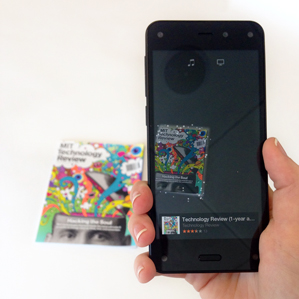The Amazon Fire’s Fanciest Features Fail to Impress
The Amazon Fire is a good smartphone, but not because of all the high-tech new features Amazon is touting. In fact, some of those features are more wearying than truly useful.

The Fire Phone has everything you actually need: fast Internet access, a high-quality camera, good maps, and countless apps, available through Amazon’s own app store. But Amazon has chosen to highlight several more unusual features in its marketing campaign—the phone’s “dynamic perspective” display, Firefly feature, and Mayday support service. Unfortunately, that stuff didn’t impress me nearly as much.
The new tricks certainly seem to make the Fire stand out, at least at first. The dynamic perspective, for instance, is pretty cool. Using sensors in each of the four corners of the display side of the phone, the device can detect how it’s moving relative to your face, and use that information to create a 3-D effect on screen. This was a mild crowd pleaser among my friends, but beyond eliciting a few oohs and aahs, it didn’t add much.
The Mayday support service is another unique feature, and it could be great, especially for newbies, but it isn’t there yet. If you have a question about your phone, you just hit the Mayday icon on the display, and within seconds, you’re video chatting with someone from Amazon’s help desk (you see the person, but he or she sees only your phone screen). If need be, the Amazon rep can take control of your phone and walk you through whatever you need help with.
Unfortunately, the two times I used the service—once to ask how to display the time on my home screen and once to ask why I got an error message when I tried to take a panoramic photo—the representatives had to scramble for answers. In the first case, a guy took control of my phone and played around with it until he figured out how to change the display (I could have done that). In the second case, a woman had to ask me to hold on while she did some research.
Mayday is still a welcome addition, if for no other reason than it’s nice to have people there to help you work through a problem, even if they don’t have an answer right away. In a world of automated customer service, talking to a human being is refreshing.
And finally, the Firefly feature. This one is both impressive and off-putting. It’s impressive because you can point the phone at just about any object, and usually it will recognize what it is. Firefly doesn’t work on everything, but it recognized the latest issue of MIT Technology Review sitting on my desk, and a bunch of other objects like a can of pumpkin and a box of staples. It can also recognize music as well as TV shows and movies, in case you want to buy something you only caught a snippet of.
Firefly is off-putting because it seems like little more than a way to get people to buy more products from Amazon. Whenever Firefly recognizes an object, the first thing it asks is whether you want to buy it. Even when the object isn’t really a product, Amazon turns it into one. For example, when my roommates and I were Firefly-ing everything in our kitchen, the Sam Adams logo on one of our pint glasses turned into a Samuel Adams Boston Lager Metal Sign starting at $20.50, and the picture of Bill Clinton my roommate pulled up on his iPhone turned into the 2000 State of the Union Address audio CD starting at $10.99.
For all its new capabilities, Amazon’s Fire Phone just goes to illustrate the smartphone industry as a whole. With device makers working so hard to stand out from the pack, even the most technologically impressive feats can start to seem like they’re trying a bit too hard.
Keep Reading
Most Popular
Large language models can do jaw-dropping things. But nobody knows exactly why.
And that's a problem. Figuring it out is one of the biggest scientific puzzles of our time and a crucial step towards controlling more powerful future models.
The problem with plug-in hybrids? Their drivers.
Plug-in hybrids are often sold as a transition to EVs, but new data from Europe shows we’re still underestimating the emissions they produce.
Google DeepMind’s new generative model makes Super Mario–like games from scratch
Genie learns how to control games by watching hours and hours of video. It could help train next-gen robots too.
How scientists traced a mysterious covid case back to six toilets
When wastewater surveillance turns into a hunt for a single infected individual, the ethics get tricky.
Stay connected
Get the latest updates from
MIT Technology Review
Discover special offers, top stories, upcoming events, and more.